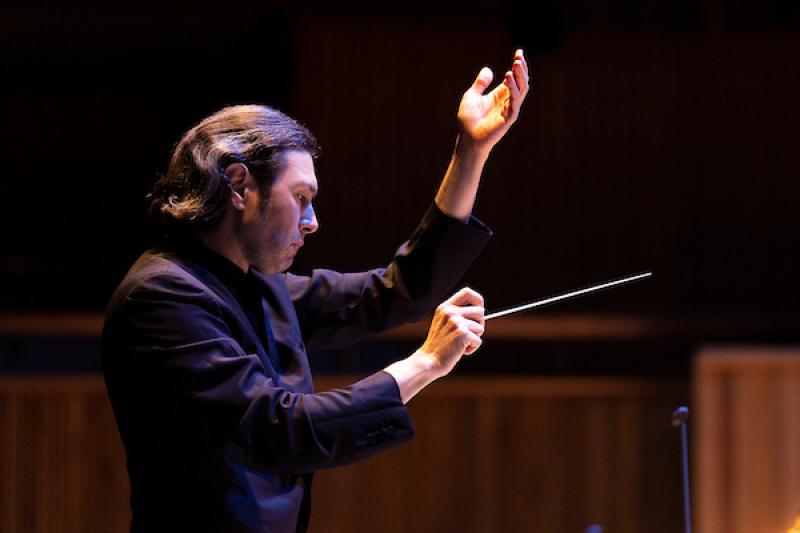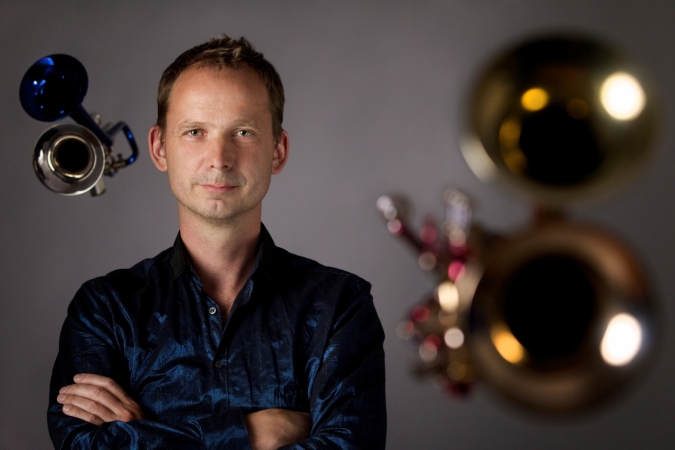Blaauw, LPO, Jurowski, RFH review - Beethoven seen in '2020 Vision' | reviews, news & interviews
Blaauw, LPO, Jurowski, RFH review - Beethoven seen in '2020 Vision'
Blaauw, LPO, Jurowski, RFH review - Beethoven seen in '2020 Vision'
Playful aspects in eclectic Beethoven anniversary programme

It’s Beethoven with everything for 2020, the composer’s 250th anniversary year. But the London Philharmonic has devised an interesting approach for their Beethoven-themed programming.
The London Philharmonic fielded a relatively large string section for the Beethoven, but with their disciplined ensemble, they were as agile as a string quartet. The rich string sound balanced the rhythmic clarity and precision that Jurowski brought to the score. Ever-tasteful in the Classical-era repertoire, Jurowski never exaggerated any of Beethoven’s dramatic gestures. The Andante cantabile second movement felt a little stiff, as if the woodwind melodies could do with more freedom, but Jurowski’s rhythmic focus proved ideal for the scherzo that followed. In the finale, Jurowski toyed playfully with the stop-and-start introduction, but launched into the movement proper with vivacious energy, drawing impressively broad textures from the strings, but without ever compromising the rhythmic focus.
Snatches of a Conversation could be a trumpet concerto, but it could equally be a work of absurdist theatre. It is scored for a speaker (Omar Ebrahim) and a trumpeter (Marco Blaauw, pictured below by Klaus Rudolph), playing a double-bell instrument. The second bell projects upwards from the body of the instrument, Dizzy Gillespie-style, and allows the player to alternate quickly between open and muted sounds. The speaker is hardly a soloist, he sits at the back of the ensemble, here obscured by a large loudspeaker, and his words are amplified.  As the title suggests, the text is made up of brief snatches of trivial conversation, to which the trumpet responds with a range of quasi-vocal textures and virtuosic outbursts. The style is jazzy, especially in the trumpet part, but also from the small ensemble, which includes prominent saxophone and trombone. The surrealism also looks back to Berio’s Sinfonia, although Eötvös is more playful and impulsive. The work received an excellent performance here, with Blaaw a suitably virtuosic and extrovert soloist, and Ebrahim a suitably surreal conversationalist. As in the opening of Beethoven’s finale, Jurowski again delivered perfect comic timing.
As the title suggests, the text is made up of brief snatches of trivial conversation, to which the trumpet responds with a range of quasi-vocal textures and virtuosic outbursts. The style is jazzy, especially in the trumpet part, but also from the small ensemble, which includes prominent saxophone and trombone. The surrealism also looks back to Berio’s Sinfonia, although Eötvös is more playful and impulsive. The work received an excellent performance here, with Blaaw a suitably virtuosic and extrovert soloist, and Ebrahim a suitably surreal conversationalist. As in the opening of Beethoven’s finale, Jurowski again delivered perfect comic timing.
Scriabin’s Second Symphony is as difficult to pin down as the Eötvös. It is a huge, late-Romantic work, indulgently expansive, and with many moments of great beauty. The music seems to alternate between two sides of Scriabin’s personality, with genteel string passages, that can sound as reserved as Elgar, leading to dissonant brass-laden climaxes as fraught and angst-ridden as anything from the Second Viennese School. Jurowski proved the ideal guide through this complex maze of colours and moods. He shaped the first movement with a firm hand, reigning in the composer’s excesses and clearly delineating the returning themes. Disciplined string coordination, this time from a huge ensemble, brought textural and harmonic clarity. Some excellent woodwind solos also stood out, especially the clarinet solos of Benjamin Mellefont in the first movement, and the birdcalls of flautist Juliette Bausor in the third.
The lower brass were less focussed, especially in the first movement, where Scriabin’s orchestration is often dense and bottom heavy. But they fared better in the finale, a triumphant Maestoso that seems pasted onto the end of the otherwise dark and sombre work. Jurowski played this for all it was worth, and every section of the orchestra shone for these final few minutes. The symphony is a curiosity, but Jurowski made the best possible case for it, skilfully shaping the music to bolster its flimsy structure, but without underplaying its many beguiling eccentricities.
rating
Explore topics
Share this article
The future of Arts Journalism
You can stop theartsdesk.com closing!
We urgently need financing to survive. Our fundraising drive has thus far raised £49,000 but we need to reach £100,000 or we will be forced to close. Please contribute here: https://gofund.me/c3f6033d
And if you can forward this information to anyone who might assist, we’d be grateful.

Subscribe to theartsdesk.com
Thank you for continuing to read our work on theartsdesk.com. For unlimited access to every article in its entirety, including our archive of more than 15,000 pieces, we're asking for £5 per month or £40 per year. We feel it's a very good deal, and hope you do too.
To take a subscription now simply click here.
And if you're looking for that extra gift for a friend or family member, why not treat them to a theartsdesk.com gift subscription?
more Classical music
 Echo Vocal Ensemble, Latto, Union Chapel review - eclectic choral programme garlanded with dance
Beautiful singing at the heart of an imaginative and stylistically varied concert
Echo Vocal Ensemble, Latto, Union Chapel review - eclectic choral programme garlanded with dance
Beautiful singing at the heart of an imaginative and stylistically varied concert
 Scott, Irish Baroque Orchestra, Whelan, RIAM, Dublin review - towards a Mozart masterpiece
Characteristic joy and enlightenment from this team, but a valveless horn brings problems
Scott, Irish Baroque Orchestra, Whelan, RIAM, Dublin review - towards a Mozart masterpiece
Characteristic joy and enlightenment from this team, but a valveless horn brings problems
 Classical CDs: Voice flutes, flugelhorns and froth
Baroque sonatas, English orchestral music and an emotionally-charged vocal recital
Classical CDs: Voice flutes, flugelhorns and froth
Baroque sonatas, English orchestral music and an emotionally-charged vocal recital
 Kanneh-Mason, Britten Sinfonia, Shave, Milton Court - a grin and a big beaming smile
A pair of striking contemporary pieces alongside two old favourites
Kanneh-Mason, Britten Sinfonia, Shave, Milton Court - a grin and a big beaming smile
A pair of striking contemporary pieces alongside two old favourites
 theartsdesk at the New Ross Piano Festival - Finghin Collins’ musical rainbow
From revelatory Bach played with astounding maturity by a 22 year old to four-hand jazz
theartsdesk at the New Ross Piano Festival - Finghin Collins’ musical rainbow
From revelatory Bach played with astounding maturity by a 22 year old to four-hand jazz
 First Person: Manchester Camerata's Head of Artistic Planning Clara Marshall Cawley on questioning the status quo
Five days of free events with all sorts of audiences around Manchester starts tomorrow
First Person: Manchester Camerata's Head of Artistic Planning Clara Marshall Cawley on questioning the status quo
Five days of free events with all sorts of audiences around Manchester starts tomorrow
 Goldscheider, Brother Tree Sound, Kings Place review - music of hope from a young composer
Unusual combination of horn, strings and electronics makes for some intriguing listening
Goldscheider, Brother Tree Sound, Kings Place review - music of hope from a young composer
Unusual combination of horn, strings and electronics makes for some intriguing listening
 theartsdesk Q&A: composer Donghoon Shin on his new concerto for pianist Seong-Jin Cho
Classical music makes its debut at London's K-Music Festival
theartsdesk Q&A: composer Donghoon Shin on his new concerto for pianist Seong-Jin Cho
Classical music makes its debut at London's K-Music Festival
 Helleur-Simcock, Hallé, Wong, Bridgewater Hall, Manchester review - moving lyricism in Elgar’s concerto
Season opener brings lyrical beauty, crisp confidence and a proper Romantic wallow
Helleur-Simcock, Hallé, Wong, Bridgewater Hall, Manchester review - moving lyricism in Elgar’s concerto
Season opener brings lyrical beauty, crisp confidence and a proper Romantic wallow
 Kohout, Spence, Braun, Manchester Camerata, Huth, RNCM, Manchester review - joy, insight, imagination and unanimity
Celebration of the past with stars of the future at the Royal Northern College
Kohout, Spence, Braun, Manchester Camerata, Huth, RNCM, Manchester review - joy, insight, imagination and unanimity
Celebration of the past with stars of the future at the Royal Northern College

Add comment